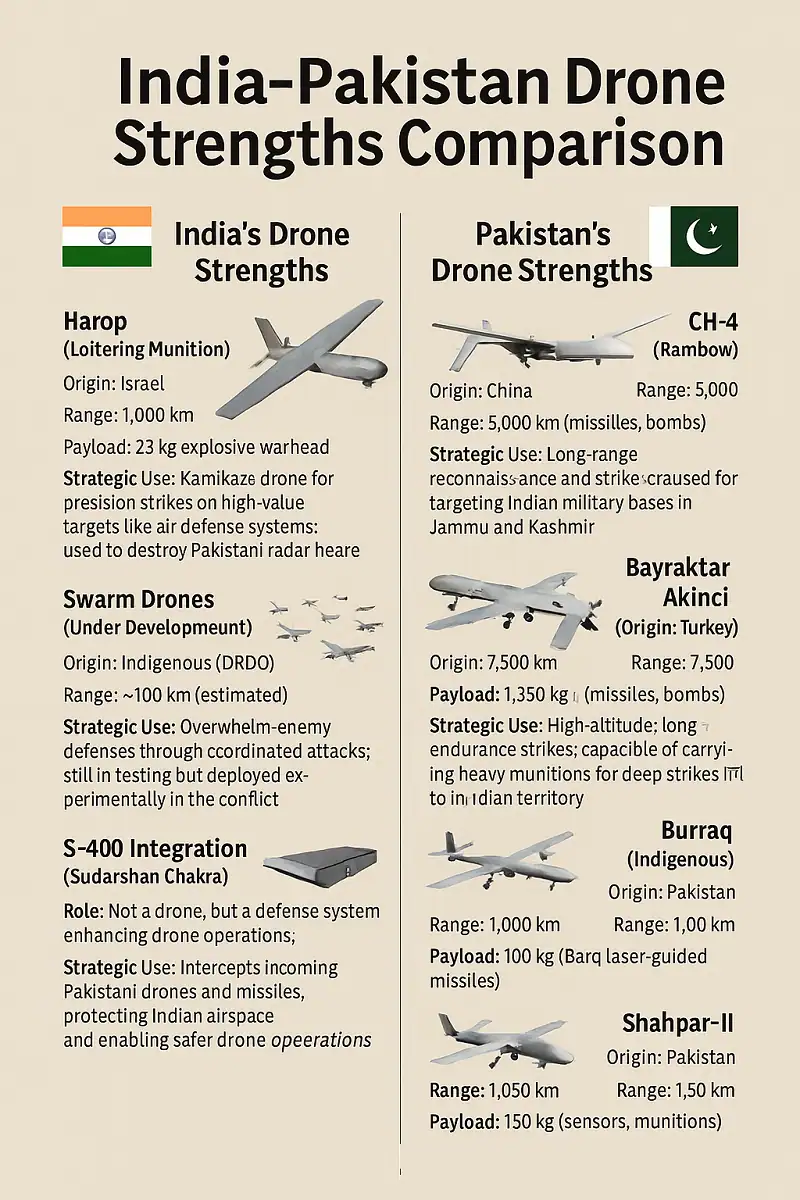In recent years, drone technology has reshaped modern warfare, becoming a cornerstone of military strategy for nations worldwide. In South Asia, Pakistan has emerged as a significant player in the development and deployment of unmanned aerial vehicles (UAVs), leveraging both indigenous innovation and strategic partnerships with countries like China and Turkey. This article explores Pakistan’s drone strength, their strategic implications, and a comparative analysis with India’s drone program, highlighting the evolving dynamics of regional security.
Pakistan’s Drone Capabilities
Pakistan’s drone program began in earnest in 2009 with the development of the Burraq, an indigenous unmanned combat aerial vehicle (UCAV) designed for intelligence, surveillance, and reconnaissance (ISR) missions, later upgraded for precision strikes. The Burraq, inspired by the American Predator and Chinese CH-3 Rainbow, carries the Barq laser-guided missile, akin to the Hellfire, and has been deployed in counterterrorism operations in Waziristan.

The Shahpar-II, a Medium Altitude Long Endurance (MALE) UAV, represents a significant advancement, boasting a 14-hour endurance, a 300 km data link range, and capabilities for ISR and disaster relief. Its development since 2017 underscores Pakistan’s focus on enhancing operational flexibility.
Pakistan’s drone arsenal also includes imported platforms, reflecting its strategic alliances. From China, Pakistan has acquired the CH-4B and Wing Loong II, both combat-proven drones with 40-hour endurance and precision strike capabilities. Turkey has supplied the Bayraktar TB2 and Akinci, which offer 27 and 24 hours of endurance, respectively, and have been battle-tested in conflicts like Nagorno-Karabakh. The Shahpar-III, a Group 4+ MALE UCAV unveiled recently, showcases Pakistan’s ambition to compete with global standards, featuring advanced ISR and strike capabilities.
Estimates suggest Pakistan operates around 300 drones, a mix of indigenous and foreign platforms, making it a formidable force in the region.
The Pakistan Air Force (PAF) and Navy have integrated drones into their operations, with the Navy employing UAVs like the Scan Eagle and Uqab for maritime surveillance. Pakistan’s drone program also supports asymmetric warfare. This dual-use capability—military and subversive—amplifies Pakistan’s strategic leverage but raises concerns about regional stability.
Key drones in Pakistan’s arsenal include:
- CH-4 and Wing Loong II (China): These medium-altitude, long-endurance (MALE) drones are capable of both surveillance and strike missions, with the ability to carry a variety of Chinese air-to-ground munitions.
- Bayraktar TB2 and Akinci (Turkey): The TB2 provides reliable surveillance and precision strike capabilities, while the Akinci offers high-altitude, long-endurance operations and advanced payload options.
- Shahpar-II (Pakistan): An indigenous UAV, the Shahpar-II can fly at altitudes up to 20,000 feet, equipped for both surveillance and air-to-ground missile strikes.
- Burraq (Pakistan): Pakistan’s first indigenously developed armed drone, capable of carrying laser-guided missiles for precision targeting.
- Falco (Italy): Initially used for surveillance, the Falco fleet is reportedly being upgraded for combat roles.
In 2024, Pakistan unveiled a new “suicide drone” at the IDEAS defense exhibition. This loitering munition can fly up to 6,000 feet and deliver precision strikes using 60mm and 81mm bombs, marking a significant leap in Pakistan’s indigenous drone strike capabilities.
Strategic Implications
Pakistan’s drone strength enhances its deterrence and asymmetric warfare capabilities, particularly against India. Drones provide cost-effective surveillance along the Line of Control (LoC) and enable precision strikes without risking human pilots. The integration of advanced sensors and wide-field cameras in platforms like the Shahpar-II and Wing Loong II allows Pakistan to monitor Indian military movements closely. However, the use of drones for smuggling and alleged terrorist activities, such as the alleged 2021 Jammu Air Force base attack, has escalated tensions, prompting India to bolster its counter-drone measures.
Pakistan’s reliance on foreign suppliers, particularly China and Turkey, reduces developmental costs but introduces dependency. Indigenous efforts like the Shahpar-III aim to mitigate this, aligning with Pakistan’s goal of self-reliance. Yet, budgetary constraints limit the scale of its program compared to wealthier nations, making strategic partnerships critical.
India-Pakistan Drone Strength Comparison
India’s drone program, while more extensive in scale, contrasts with Pakistan’s in focus and resources. By mid-2024, India had inducted 2,000–2,500 drones, with expenditures between $361.45 million and $421.69 million, dwarfing Pakistan’s estimated 300 units. India’s arsenal includes advanced platforms like the IAI Heron, Heron TP, and the recently approved 31 MQ-9B Sky Guardian drones from the U.S., costing $3 billion. These platforms offer superior endurance (up to 52 hours for the Heron) and multi-role capabilities, including ISR and precision strikes. India’s DRDO Rustom and Ghatak projects aim for indigenous stealth UCAVs, though earlier models like Nishant faced setbacks.

A key differentiator is India’s swarm drone technology, with systems like the heterogeneous swarm UAV by NewSpace Research & Technologies, inducted in February 2023. Swarm drones can overwhelm defenses, targeting high-value assets, and are integrated with precision missile systems like the Agni-P, posing a strategic threat to Pakistan’s nuclear delivery vehicles. Pakistan lacks comparable swarm capabilities, relying instead on versatile but less coordinated platforms like the TB2 and CH-4.
India benefits from a robust ecosystem of over 200 drone startups, enabling rapid replacement and innovation, while Pakistan’s industry, though growing, is smaller and less diverse. India’s acquisitions from the U.S. and Israel, including Heron TP and Harop drones, enhance its electronic warfare and counter-radar capabilities, areas where Pakistan trails. However, Pakistan’s combat-proven drones, particularly the TB2, have demonstrated efficacy in real-world conflicts, giving it a tactical edge in certain scenarios.
Regional Dynamics and Future Outlook
The drone race between India and Pakistan risks intensifying an arms race, with both nations viewing UAVs as strategic tools. India’s larger budget ($75 billion vs. Pakistan’s $7.64 billion) and global partnerships give it a quantitative and technological edge, but Pakistan’s focus on cost-effective, combat-ready drones ensures it remains a credible threat.
To mitigate escalation risks, confidence-building measures (CBMs) like AI-driven transparency and crisis communication systems are vital. Pakistan must balance indigenous development with strategic acquisitions to counter India’s advancements, while India’s push for self-reliance through projects like Ghatak could widen the gap. As drones become integral to South Asian security, their responsible use will determine whether they stabilize or destabilize the region.







